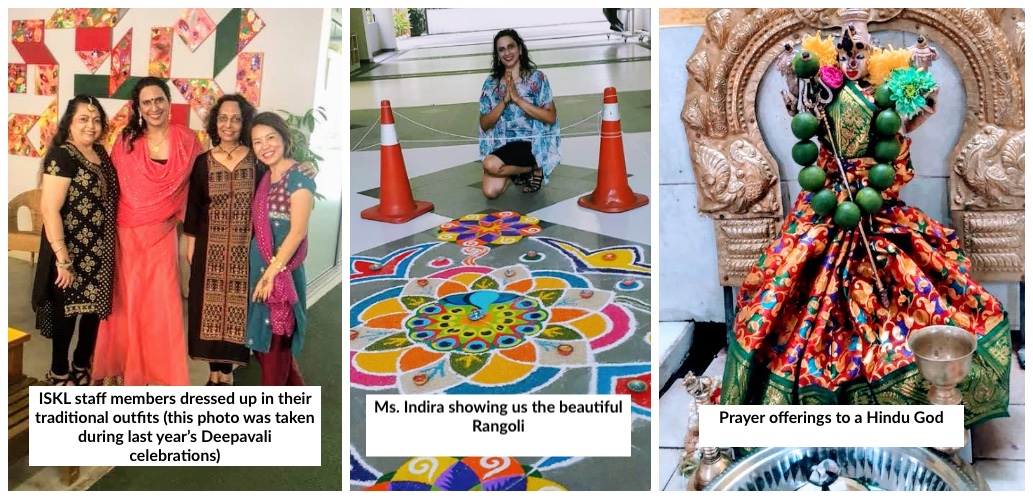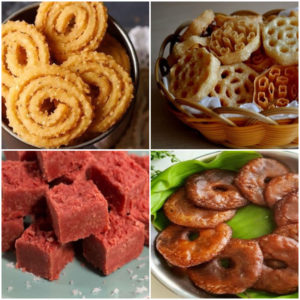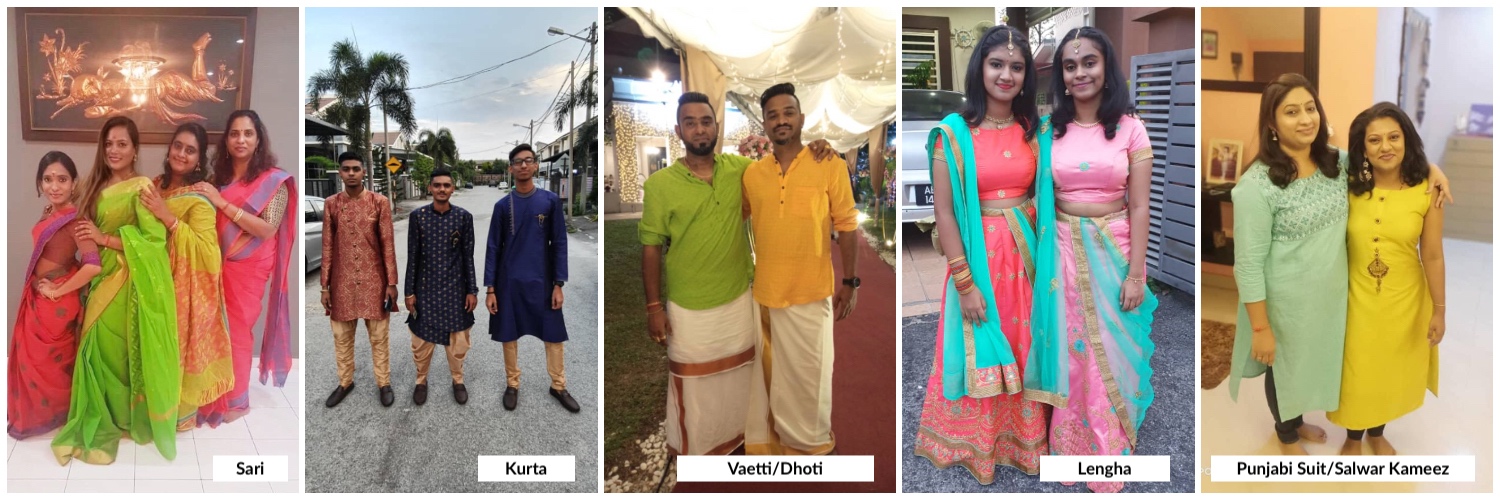This week, we are celebrating Deepavali! We have some special guests from our Staff Association who will be helping us learn more.
Ms. Indira Muniandy from the Staff Association tells us about the festival:
Deepavali, also known as Diwali, is one of the most auspicious festivals for Hindus residing in Malaysia and across the globe. The word Deepavali means “a row of lights”. It is celebrated in the month of Aippasi in the Tamil calendar (October-November), during the period when there is no visible moon. This year, it falls on Saturday, November 13, 2020.
Hindus believe that it signifies the triumph of brilliance over darkness and good over evil. On the eve of Deepavali, most Hindus in Malaysia will decorate their houses with Rangoli, which is a drawing made from colorful rice flour to welcome their guests.
On the morning of Deepavali, the head of the family will anoint every family member’s head with oil, and after that, they will take a bath to cleanse themselves. Then, everyone wears their new clothes and offers prayers at home or at the temple. After the prayers, there will be visits to relatives’ houses and usually, housewives will bring along small boxes of sweets.

Deepavali Delicacies
Ms. Punita Subramaniam, from our Human Resources team, shares her gastronomic experience with us. Thank you for sharing this with us Punita, we are all getting hungry just reading about your delicious Deepavali delicacies!
What is a Deepavali celebration without food? It’s a day filled with scrumptious feasts for everyone to enjoy, from the young to old. During this day, a variety of traditional colorful sweets with different flavors and savory dishes are served. It is customary to make these dishes at home for the celebration. The type of food that is served depends on the culture and traditions followed by the family.
In my family, we start our day with a wide spread of breakfast food that consists of dosa, idli, idiyappam, and vada. Dosa is a crispy thin crepe made of fermented rice-and-lentil batter. The same batter is used to make idli, a steamed rice cake that is soft and fluffy. Both of these are eaten with vegetable kurma and coconut chutney for vegetarians. Some non-vegetarian options include chicken/mutton curry, and chicken/mutton varuval.


 Another must-have is vada, a doughnut-shaped fried fritter made from a batter of black lentils, gently spiced with peppercorns, curry leaves, cumin, chilli, and onions. This crunchy fritter tastes best when smeared generously with coconut chutney or sambar. In addition to that, we have the idiyappam, also known as string hopper, which is another favorite breakfast dish. It’s made of rice flour pressed into noodles, woven into a flat disc-like shape, and steamed, served with brown sugar and grated coconut. And for those who like it savory, you can eat it with sambar, chicken/mutton curry, or any gravy-like sauce.
Another must-have is vada, a doughnut-shaped fried fritter made from a batter of black lentils, gently spiced with peppercorns, curry leaves, cumin, chilli, and onions. This crunchy fritter tastes best when smeared generously with coconut chutney or sambar. In addition to that, we have the idiyappam, also known as string hopper, which is another favorite breakfast dish. It’s made of rice flour pressed into noodles, woven into a flat disc-like shape, and steamed, served with brown sugar and grated coconut. And for those who like it savory, you can eat it with sambar, chicken/mutton curry, or any gravy-like sauce.
Our lunch menu typically consists of briyani, a rice dish made with a mixture of spices, mint leaves, fried onions, and yogurt. It is eaten with dhalcha, a chicken/mutton dish, cucumber raita, and stir fried vegetables. On top of all those savory dishes, we also indulge in a variety of homemade traditional snacks like murukku, achimurukku, coconut candy, athirasam, and assorted biscuits throughout the day. A must-have snack during Deepavali would definitely be murukku. Murukku is a savory, crunchy snack made from rice flour and urad dal flour, along with a perfectly balanced blend of spices that add a burst of flavor.
Deepavali Attire
Even though most of these dishes and snacks are available all year long, what makes it special on Deepavali is feasting with family and friends, adorning our new traditional wear, playing with sparkles, and enjoying the day to the fullest.
Ms. Carmela Ganeson, ISKL’s School Nurse from the High School Student Health Services tells us about the traditional outfits that are usually worn during Deepavali, and shares some beautiful photos of her family. Thank you for this lovely contribution, Carmela!
The celebration of Deepavali, also known as the Festival of lights, is marked by vibrant colors, as well as the themes of light and illumination. Hence, it is quite right to say that Deepavali is a cheerful time to “dress to excess” and reflect the joy and excitement of this day. Most clothing for Deepavali is brightly colored and new to symbolize the appreciation for Goddess Lakshmi, the goddess of light and prosperity.
On the morning of Deepavali, many Hindus will take an oil bath before heading to the temples for prayers or some might pray at home. It is normal to wear new attire to mark the celebration.
Here are some examples of Deepavali attire for both men and women, and some fun facts related to the attire.
Sari
A sari, which is often misspelled as Saree, is a garment that consists of a 6-9 meter long draped cloth. The Sari is a Hindustani word, which means “strip of cloth” in Sanskrit.
Indian women all over the world feel pride in wearing the sari on almost all occasions, festivals, and celebrations.
There are more than 80 recorded ways to wear a sari.
There are no age restrictions on wearing a sari – anyone can wear one 😊
Kurta and Vaetti/Dhoti
A kurta is traditionally made of cotton or silk. This attire is popular among men as it is modest and comfortable. A kurta is usually worn with vaetti/dhoti, pants or jeans.
Vaetti (South Indian)/Dhoti (North Indian) is another well-known traditional attire for an Indian man. It’s a type of sarong, usually 4.5 – 6 meters long, wrapped around the waist or knotted between the waist and the legs.
Lehnga
Lehnga is a full ankle-length skirt worn by women. Lenhga was worn in old Hindu tradition and was believed to awaken the spiritual chakras of the body as well as considered as one of the appropriate garments as per the Hindu culture.
Punjabi Suit/ Salwar Kameez
Punjabi suit (South Indian)/ Salwar Kameez (North Indian) is a traditional combination dress worn by women and men in some regions in South Asia. It is a combination of kameez or kurti (the top) and salwar/ trousers (the bottom). Sometimes it is worn with a colorful dupatta (shawl) to make it look even more grand. This attire is worn by people of all ages.



